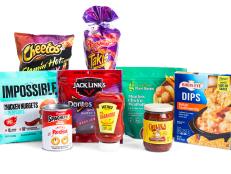How Today's Supermarkets Are Totally Changing the Way You Shop
A look into how technology is changing how we shop for food.

Hoxton/Tom Merton
If you've downloaded a supermarket's app, ordered groceries online, or sat down with a cup of coffee inside a grocery store, you can sense that the way we buy food these days is changing. Innovations in the grocery industry have been simmering for a while now, but lately it feels like things are ramping up. In particular, tech behemoth Amazon's recent purchase of Whole Foods (and how quickly they're already dropping prices at the notoriously spend-y chain) signals coming disruption that's going to be bigger than meal kits or digital coupons.
Robert Hetu, research director for Gartner, an information technology research company that advises retail clients, and Joseph Turow, author of the new book The Aisles Have Eyes, and professor at the Annenberg School for Communications at the University of Pennsylvania, agree that although grocery stores once lagged behind in this era's culture of change, they're quickly catching up. Here's how technology and other new tactics are totally altering your food shopping experience — whether you realize it or not.
Most of us are still shopping at brick and mortars, but online shopping (and that automatic re-order feature) is on the rise.
"Most grocery-store shopping is still done in the traditional way," Hetu says. But he thinks that by "by 2020, about 50-percent of home products will be auto-replenished." If you choose to have regular purchases (detergent, sandwich bags, even snacks) magically appear on your doorstep every so often, it totally changes your relationship with your grocery store.
Not only do auto-reordering features provide companies with data about how you use their products, but they also automate your loyalty to a specific brand. In a store, you might pass over your usual item if you see something new (or different brand at a sale price) on shelves. But if the same ol' dish soap shows up instantly, comparison shopping is not top of mind.

Maskot
And when we do shop in stores, companies are getting us to reveal exactly where we are inside.
These days, retailers aren't only interested in what you buy, but also your shopping patterns and behaviors — and today's technologies provide more insights than ever before.
For instance, grocery stores will entice you to download their apps (the allure of discounts makes that pretty easy), keep them running, and enable location-tracking. Then, they can potentially pinpoint the aisle you're in, how long you've been there, and what product you're looking at. In the future, here's how they could use that data: Let's say you stand in front of some fancy tuna and consider it for a while. You're undecided — but then a notification pops up on your phone offering a discount for that tuna. Are you willing to share this much data to score a deal? More and more, we're doing it without batting an eye. "Stores are basically teaching us that to get along in the 21st century, you have to give up your data," says Turow.
If you connect to a store's WiFi network, they're tracking you more easily that way, too. And a store's beacon technology, which tries to "wake up" the apps on your phone when you walk in, can also find you. "If you think your app is off, you could be wrong," says Turow. "A lot of apps sleep — but then can open and follow you."
And even non-grocery apps could get some skin this game. It might seem strange for, say, a music-streaming app to request access to your location. Why would it need to know where you are? Well, that music company might sell that data to other companies (like your grocer), if such intent is outlined in its privacy policy — which few of us read, Turow says. Take a look at those agreements to know what permissions you've granted an app and then you can really decide if you're comfortable with it.
So stores are working harder to get us in the door — and then stick around.
These days, attention spans are short, calendars are full, and we're more likely to turn to digital shopping options than ever before. In response, have you noticed it feels a like a party in your supermarket lately? Some upscale grocers are trying out offering fun add-ons like wine tastings, cooking demos, coffee shops or even restaurants. "Those are certainly smart ways to help encourage the customers to stay in the store," Hetu says. They're fighting our tendency to want an in-and-out experience when we shop for food.

David Ryder
But some stores are leaning into the customer's desire to get in and out faster than ever.
Small format stores (where it's easier to grab-and-go), curbside pickup and self-checkout machines are newer tactics aimed at helping busy shoppers, and some companies are exploring ways to make grocery shopping even more frictionless. Amazon recently began to test a store in Seattle in which customers' every moves are tracked and payment is automatic.
You scan your phone when you walk in, which logs you into the store's network. (Sound familiar? Yes, they're collecting data at this point, too.) Take something from the shelf, and sensors and artificial intelligence will know that you picked it up (or if you put it back). When you're done shopping, your virtual cart will have logged everything you grabbed, you leave the store, and Amazon charges your account. No money changes hands, and there is no checkout line.
Artificial intelligence and virtual reality are the next frontier.
Maybe you already call to Siri to add paper towels to your grocery list, or ask Google Assistant for recipe recommendations. In the not-so-distant future, you'll likely be able to take that technology into the grocery store with you and use AI to get recipe recommendations, nutritional info, or find the location of a product in a store. "Voice-driven apps are going to make a very big difference," Hetu says.
Virtual reality has yet to be widely integrated in supermarkets, but Hetu points to Lowe's new VR experience (which helps customers learn to do DIY projects, like install tile) as an example of how retailers are experimenting with the technology. Imagine being able to "walk around" and browse a virtual supermarket without even having to leave your couch — one day, that could be as mundane as getting into your car and actually going to the supermarket now.
And could chip implants be the frequent-shopper card of the future?
"A consultant I listened to at an industry conference thinks that by 2028 people will have chips in their arms," Turow says. By doing so, "a store could lower a price if you have a physical reaction reveals that you're nervous. Or if they see that you're holding the product for a certain number of seconds, they might change the price."
This sounds like something out of a sci-fi movie, but one company in Wisconsin recently put chips in the arms of employees who volunteered to try it out; the chips allow them to open doors, log-on to computers and buy snacks with just the wave of hand.
As consumers, it's important to stay informed about these new technologies and marketing tactics, and take stock of how they might be changing your shopping habits — otherwise, you might not even realize it. But also don't forget to marvel at the fact that the future is here, and it's weird.
Related Links:
—
Alex Van Buren is a food and travel writer living in Brooklyn, New York whose work has appeared in Gourmet.com, Bon Appétit, Travel & Leisure, New York Magazine, Martha Stewart Living, and Epicurious. Follow her on Twitter and Instagram @alexvanburen.
Photos: Hoxton/Tom Merton/Getty; Maskot/Getty; David Ryder/Getty






























































